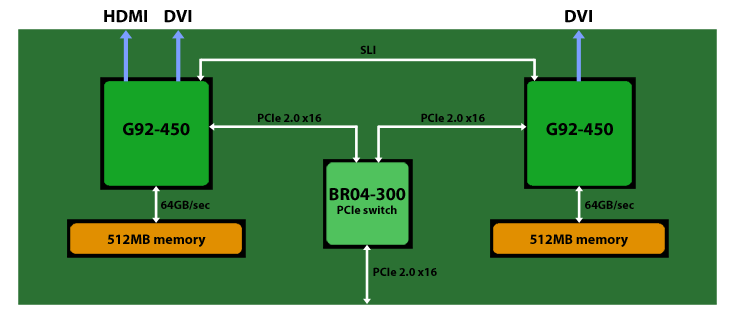GeForce 9800 GX2 architecture
Despite the new nomenclature, there isn't a lot of technology in the GeForce 9800 GX2 that we haven't seen in other recent Nvidia products. If anything, it's more of an amalgamation of technologies that we've already seen in the past.The GeForce 9800 GX2 has gone back to the brute force methods Nvidia used to retain the performance crown when it launched the GeForce 7950 GX2 and it's based on a couple of 65nm G92-450 chips, meaning there is a total of 1,508 million (1.508 billion) transistors or 754 million per GPU.
We're not going to go into massive amounts of detail on the GPU architecture, because it's ground we've covered a lot in the past and it should be a very familiar design if you're a technology follower. If you're not sure what's going on here, please check out our original G80 architecture review along with our GeForce 8800 GT and GeForce 8800 GTS 512MB reviews, as they both utilise the G92 graphics chip.
Each of the G92-450 GPUs features the full 128 stream processors (split into eight shader clusters) clocked at 1,500MHz and every shader cluster has eight texture units for both addressing and filtering. Like past GPUs derived from the G80 architecture, the texture units are clocked at the 'Core Clock', just like the instruction dispatch and ROPs. In the case of the GeForce 9800 GX2, this is set at 600MHz.
While we're talking about clock speeds, if you follow the graphics industry quite closely, you'll probably notice that these frequencies are exactly the same as those on Nvidia's GeForce 8800 GT although, unlike that particular card, there are eight shader clusters enabled compared to the seven inside the G92-270 (GeForce 8800 GT) chip.
As a result of using the G92 graphics chip, the new compression technologies introduced with the GeForce 8800 GT are present in the GeForce 9800 GX2 as well – this helps to make better use of the memory bandwidth available. There are 16 ROPs (split into four clusters) in each GPU, making a total of 32 ROPs and eight clusters.

The data flow through Nvidia's GeForce 9800 GX2
Each of the ROP clusters has its own 64-bit memory channel connected to a pair of 64MB GDDR3 DRAMs clocked at 1,000MHz (2,000MHz effective), meaning each GPU has its own 256-bit memory interface and 512MB of video memory. The memory is clocked 200MHz higher than the memory on the GeForce 8800 GT, and it's even clocked higher than the 1,940MHz (effective) memory frequency on the G92-based GeForce 8800 GTS 512.
What all of this means that on paper, this is the fastest graphics card ever released. It has masses of shader and texturing horsepower on tap – there is a total of 76.8 GigaTexels per second of texture filtering muscle, 768 GigaFLOPS of shader horsepower and a fill rate of 19,200 mega pixels per second. That's pretty impressive, even if it is as a result of combining a pair of GPUs in a single PCI-Express slot to improve performance.

MSI MPG Velox 100R Chassis Review
October 14 2021 | 15:04











Want to comment? Please log in.